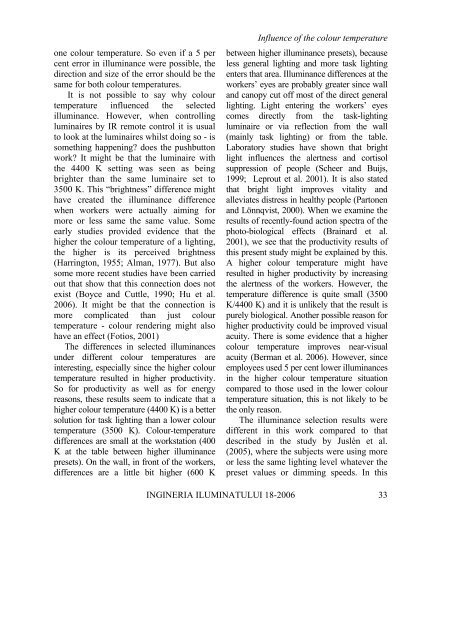This issue is sponsored by the Philips Romania, Lighting Division
This issue is sponsored by the Philips Romania, Lighting Division
This issue is sponsored by the Philips Romania, Lighting Division
Create successful ePaper yourself
Turn your PDF publications into a flip-book with our unique Google optimized e-Paper software.
one colour temperature. So even if a 5 per<br />
cent error in illuminance were possible, <strong>the</strong><br />
direction and size of <strong>the</strong> error should be <strong>the</strong><br />
same for both colour temperatures.<br />
It <strong>is</strong> not possible to say why colour<br />
temperature influenced <strong>the</strong> selected<br />
illuminance. However, when controlling<br />
luminaires <strong>by</strong> IR remote control it <strong>is</strong> usual<br />
to look at <strong>the</strong> luminaires whilst doing so - <strong>is</strong><br />
something happening? does <strong>the</strong> pushbutton<br />
work? It might be that <strong>the</strong> luminaire with<br />
<strong>the</strong> 4400 K setting was seen as being<br />
brighter than <strong>the</strong> same luminaire set to<br />
3500 K. <strong>Th<strong>is</strong></strong> “brightness” difference might<br />
have created <strong>the</strong> illuminance difference<br />
when workers were actually aiming for<br />
more or less same <strong>the</strong> same value. Some<br />
early studies provided evidence that <strong>the</strong><br />
higher <strong>the</strong> colour temperature of a lighting,<br />
<strong>the</strong> higher <strong>is</strong> its perceived brightness<br />
(Harrington, 1955; Alman, 1977). But also<br />
some more recent studies have been carried<br />
out that show that th<strong>is</strong> connection does not<br />
ex<strong>is</strong>t (Boyce and Cuttle, 1990; Hu et al.<br />
2006). It might be that <strong>the</strong> connection <strong>is</strong><br />
more complicated than just colour<br />
temperature - colour rendering might also<br />
have an effect (Fotios, 2001)<br />
The differences in selected illuminances<br />
under<br />
different colour temperatures are<br />
interesting, especially since <strong>the</strong> higher colour<br />
temperature resulted in higher productivity.<br />
So for productivity as well as for energy<br />
reasons, <strong>the</strong>se results seem to indicate that a<br />
higher colour temperature (4400 K) <strong>is</strong> a better<br />
solution for task lighting than a lower colour<br />
temperature (3500 K). Colour-temperature<br />
differences are small at <strong>the</strong> workstation (400<br />
K at <strong>the</strong> table between higher illuminance<br />
presets). On <strong>the</strong> wall, in front of <strong>the</strong> workers,<br />
differences are a little bit higher (600 K<br />
Influence of <strong>the</strong> colour temperature<br />
between higher illuminance presets), because<br />
less general lighting and more task lighting<br />
enters that area. Illuminance differences at <strong>the</strong><br />
workers’ eyes are probably greater since wall<br />
and canopy cut off most of <strong>the</strong> direct general<br />
lighting. Light entering <strong>the</strong> workers’ eyes<br />
comes directly from <strong>the</strong> task-lighting<br />
luminaire or via reflection from <strong>the</strong> wall<br />
(mainly task lighting) or from <strong>the</strong> table.<br />
Laboratory studies have shown that bright<br />
light influences <strong>the</strong> alertness and cort<strong>is</strong>ol<br />
suppression of people (Scheer and Buijs,<br />
1999; Leprout et al. 2001). It <strong>is</strong> also stated<br />
that bright light improves vitality and<br />
alleviates d<strong>is</strong>tress in healthy people (Partonen<br />
and Lönnqv<strong>is</strong>t, 2000). When we examine <strong>the</strong><br />
results of recently-found action spectra of <strong>the</strong><br />
photo-biological effects (Brainard et al.<br />
2001), we see that <strong>the</strong> productivity results of<br />
th<strong>is</strong> present study might be explained <strong>by</strong> th<strong>is</strong>.<br />
A higher colour temperature might have<br />
resulted in higher productivity <strong>by</strong> increasing<br />
<strong>the</strong> alertness of <strong>the</strong> workers. However, <strong>the</strong><br />
temperature difference <strong>is</strong> quite small (3500<br />
K/4400 K) and it <strong>is</strong> unlikely that <strong>the</strong> result <strong>is</strong><br />
purely biological. Ano<strong>the</strong>r possible reason for<br />
higher productivity could be improved v<strong>is</strong>ual<br />
acuity. There <strong>is</strong> some evidence that a higher<br />
colour temperature improves near-v<strong>is</strong>ual<br />
acuity (Berman et al. 2006). However, since<br />
employees used 5 per cent lower illuminances<br />
in <strong>the</strong> higher colour temperature situation<br />
compared to those used in <strong>the</strong> lower colour<br />
temperature situation, th<strong>is</strong> <strong>is</strong> not likely to be<br />
<strong>the</strong> only reason.<br />
The illuminance<br />
selection results were<br />
different<br />
in th<strong>is</strong> work compared to that<br />
described in <strong>the</strong> study <strong>by</strong> Juslén et al.<br />
(2005), where <strong>the</strong> subjects were using more<br />
or less <strong>the</strong> same lighting level whatever <strong>the</strong><br />
preset values or dimming speeds. In th<strong>is</strong><br />
INGINERIA ILUMINATULUI 18-2006 33
















